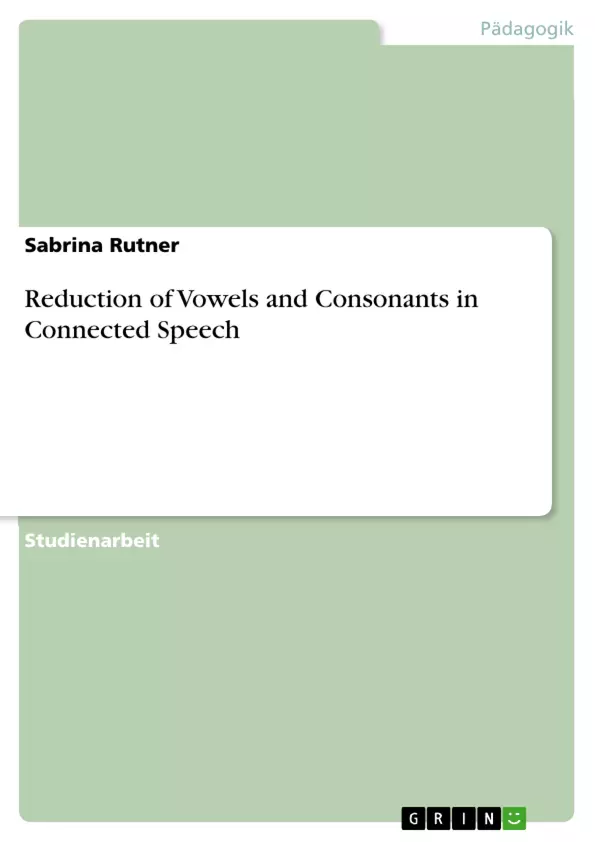In connected speech, speakers of all languages typically try to articulate in the most efficient manner. Thus, they reduce any articulatory gesture that is not necessary for the understanding of the message and several simplification processes take place. These processes systematically cause changes in the segmental structure of words in relation to their citation form. As a result, the realization of words in connected speech differs a lot from the pronunciation of the words’ citation form.
Even though native speakers are unaware of the simplification processes that naturally occur in connected speech and may even deny making them, the structure simplification that occurs in the English language is well documented in linguistic literature (Brown 1979, Giegerich 1998, Gimson 2001). Based on this literature, the paper will focus on the question which simplification processes occur in English and how vowels and consonants are reduced and modified in connected speech.
The structure simplification of segments in fluent speech is depended on phonetic, phonological, prosodic, grammatical, and discourse patterns of the language. As the structure simplification of function words is strongly connected to some of these factors, the weak form of function words and the most important factors of structure simplification will shortly be presented in the first part.
In connected speech segments lose their phonological information through different types of simplification processes that affect speech production. These are vowel reduction, elision of vowels and consonants, assimilation of consonants and liaison. All of these processes will be explained in detail and with many examples. In the end, the most important findings of the paper will be summarized.
Inhaltsverzeichnis
- Introduction
- Patterns of Structure Simplification
- Weak Forms of Function Words
- Vowel Reduction
- Elision
- Elision of Vowels
- Elision of Consonants
- Assimilation
- Assimilation of Place
- Liaison
- Linking /r/ and the Intrusive /r/
- Linking /j/ and /w/ and the Intrusive /j/ and /w/
- Conclusion
- Bibliography
Zielsetzung und Themenschwerpunkte
Die Arbeit untersucht die Strukturvereinfachung in der gesprochenen Sprache und erklärt, wie Vokale und Konsonanten in der gesprochenen Sprache reduziert werden. Sie analysiert verschiedene Prozesse der Strukturvereinfachung, die in der englischen Sprache auftreten und zeigt, wie sich die Realisierung von Wörtern in der gesprochenen Sprache von der Zitierform unterscheidet.
- Strukturvereinfachung in der gesprochenen Sprache
- Reduktion von Vokalen und Konsonanten
- Assimilation von Konsonanten
- Liaison und Intrusion
- Phonologische Prozesse in verschiedenen Sprachvarianten
Zusammenfassung der Kapitel
Das erste Kapitel führt in das Thema der Strukturvereinfachung in der gesprochenen Sprache ein und erläutert, wie Sprecher versuchen, in der effizientesten Weise zu artikulieren. Es werden verschiedene Prozesse der Strukturvereinfachung vorgestellt, die in der englischen Sprache auftreten, sowie die Auswirkungen auf die segmentale Struktur von Wörtern.
Das zweite Kapitel behandelt die Muster der Strukturvereinfachung, die in der gesprochenen Sprache auftreten. Es werden Faktoren wie Stress, Rhythmus, Tempo, Grammatik und Diskursfunktion analysiert, die die Strukturvereinfachung beeinflussen.
Das dritte Kapitel befasst sich mit der Reduktion von Vokalen in der gesprochenen Sprache. Es wird erklärt, wie Vokale in unbetonten Silben zu einem Schwa reduziert werden können und wie dies die suprasegmentale und segmentale Struktur von Wörtern beeinflusst.
Das vierte Kapitel behandelt die Elision von Vokalen und Konsonanten in der gesprochenen Sprache. Es werden verschiedene Arten der Elision erläutert, wie die Elision von Diphthong-Elementen, die Elision von Schwa und die Elision von Konsonanten in Konsonantengruppen.
Das fünfte Kapitel befasst sich mit der Assimilation von Konsonanten in der gesprochenen Sprache. Es werden verschiedene Arten der Assimilation erläutert, wie die Assimilation von Stimmhaftigkeit, die Assimilation von Nasalität und die Assimilation von Artikulationsstelle.
Das sechste Kapitel behandelt den Prozess der Liaison in der gesprochenen Sprache. Es wird erklärt, wie bestimmte Segmente, die in der Zitierform Teil von Koda sind, in der gesprochenen Sprache Teil von Onsets werden können. Es werden verschiedene Arten der Liaison erläutert, wie die Verknüpfung von /r/, /j/ und /w/ sowie die Intrusion von /r/, /j/ und /w/.
Schlüsselwörter
Die Schlüsselwörter und Schwerpunktthemen des Textes umfassen Strukturvereinfachung, gesprochene Sprache, Vokalreduktion, Elision, Assimilation, Liaison, Phonologie, englische Sprache, Phonetik, Sprachvarianten, Diskursfunktion, Stress, Rhythmus, Tempo.
- Quote paper
- Sabrina Rutner (Author), 2014, Reduction of Vowels and Consonants in Connected Speech, Munich, GRIN Verlag, https://www.grin.com/document/274716



